
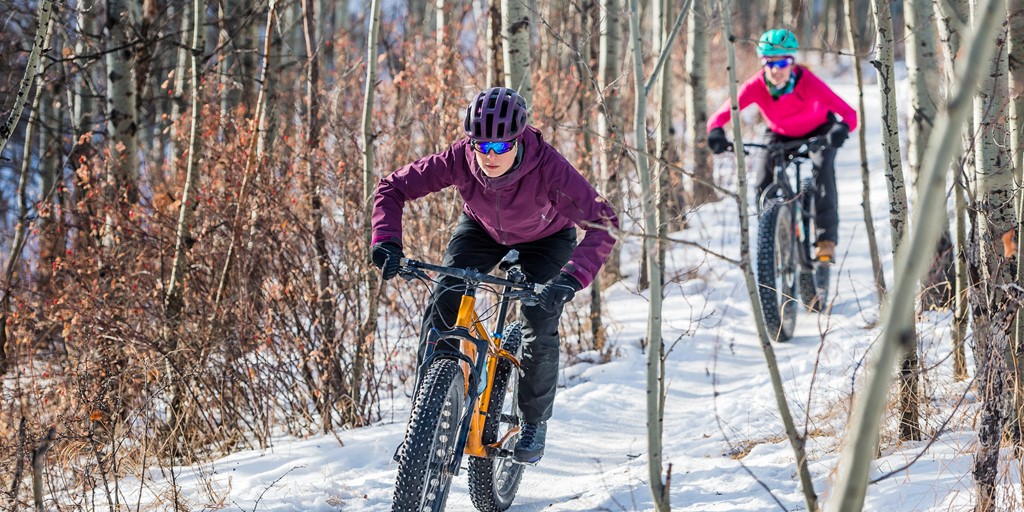
Mountain biking can throw up obstacles at the best of times, but it’s a different kettle of fish entirely in winter.
Granted—winter mountain biking is an exhilarating experience, full of all the familiar thrills and spills that make the sport so enjoyable.
However, get things wrong, and your experience of winter mountain biking can become a very miserable, uncomfortable, and even dangerous one indeed.
Like with most things, success comes from proper preparation, and we know a thing or two about that. So, swot up on these top tips for winter mountain biking, and you’ll be king or queen of the trails in no time.
Layer up
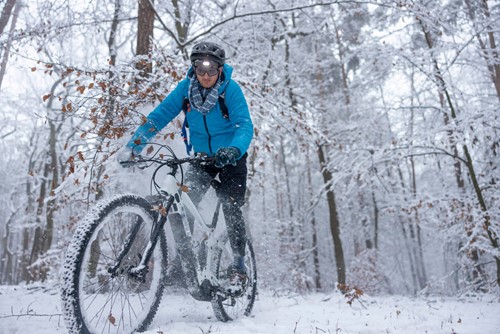
It’s super important to layer up properly before heading out on your mountain bike in the winter.
As we all know, winter weather is largely unpredictable, but one thing’s for certain—it will be cold. However, the key to being comfortable is to stay warm without getting too hot, so you must find a balance.
The best way to do this is by layering up, but making sure you have wicking fabric directly against your skin. These fabrics draw moisture away from your body, so your clothes won’t become saturated and wet from your sweat while riding.
You can never go too far wrong with a nice warm, waterproof coat either, but make sure it’s not so big and bulky that it restricts your movement.
Related: Best mountain bike jackets 2022
Wear gloves
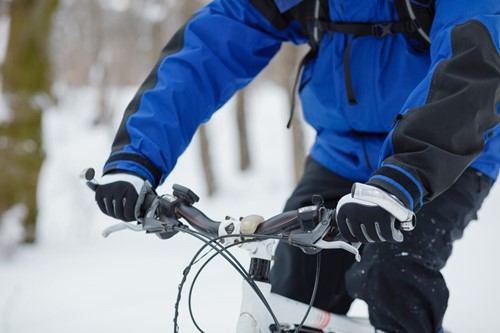
As a mountain biker, you’ll already know the importance of wearing gloves. They are essential for grip, protection, and keeping your hands warm when winter arrives.
There’s nothing worse than numb hands caused by the cold when cycling, and you should always wear gloves when mountain biking in winter.
However, you must also retain a grip on the handlebars. If you’re in the market for new gloves, look for a pair with good grip and insulation. You’ll be laughing from start to finish, whatever the weather.
Related: Best winter gloves for mountain biking
Drink plenty of fluids

Drinking cold water may not be the most appealing thing in the world when you’re outside in the cold (you’d probably prefer a flask of hot tea or coffee, right?) But the reality is you must stay hydrated while out on the trails.
You need plenty of energy for mountain biking, and hydration is key to making sure you’ve plenty of it in the tank. Not drinking enough water before (and during) a ride can mean you lack the energy you need, and you may even start to feel light-headed or dizzy—not what you want at all.
Drink plenty of water before setting off, and take a water bottle with you, too.
Wear goggles
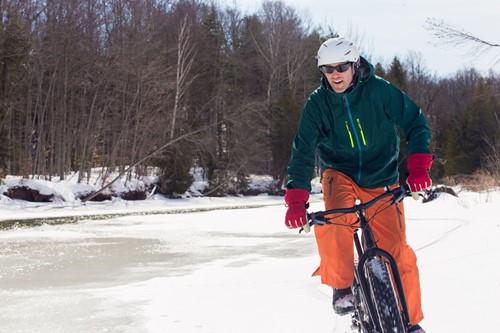
Swimming isn’t the only sport where goggles are useful. Goggles are also a worthy investment for winter mountain biking.
The trails can be pretty treacherous in the winter, with mud, puddles, and all sorts of other nastiness throwing up obstacles along your route. When you’ve got mud and dirty water splashing up into your face, you’ll be grateful for your goggles—trust us.
Goggles also keep the wind out of your eyes, stopping them from drying out.
Related: Best mountain bike goggles 2022
Consider studded tyres
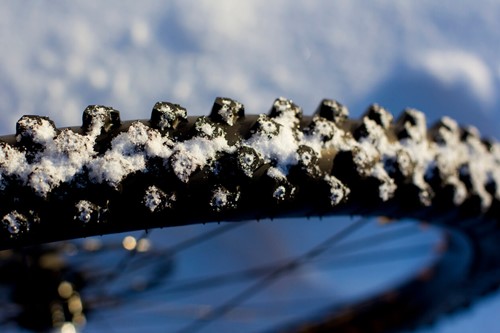
By all means, you can get away with using tyres without studs, but studs will certainly help for winter mountain biking.
While studded tyres won’t completely prevent accidents on slippery trails, they’ll make them far less likely. The studs provide additional grip against testing conditions, meaning you can tackle trickier trails with confidence.
However, if you don’t want to splash out on new studded tyres, you can always make your own. You can make your own studded tyres, usually by poking screws out through the tyre casing from the inside.
Related: How to make your own studded winter tyres
Start uphill

Though you might be more inclined to ease yourself in with a flat or even downhill stretch, climbing uphill from the off is more beneficial.
Depending on the weather conditions, you’ll likely be pretty cold before getting moving, so you’ll want to warm up quickly. Riding uphill from the start is the best way to do that.
Attach bike lights
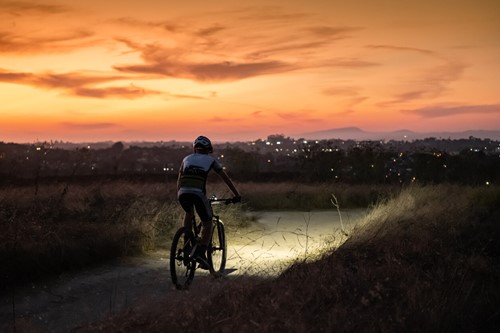
We all know that winter consists of shorter days and not much brightness. If you’re on a particularly popular trail, being visible to others is vital for avoiding accidents. So, kitting your mountain bike out with lights and wearing hi-viz, reflective gear is always a wise choice.
Related: Best mountain bike lights—reviewed and rated
Winter mountain biking preparation
As well as all of the points above, here are a few additional things to consider in your winter mountain biking preparation.
- Make sure your tyres have open tread patterns
- Use lube on your drive chain, and keep it as clean as possible
- Check that your cables are weather-sealed
- Invest in some good mudguards
- Check your brake pads
Related: 8 winter training tips for mountain bikers
Winter mountain biking: other handy tips
As you now know, there are various hazards that come with winter mountain biking, so you must equip yourself with the necessary skills to cope with them.
Mud and its accompanying slip factor are the #1 things to look out for on the trails, so here are a few more handy tips to take away.
- Concentrate—keep focused and keep your eyes on the path
- Stand up in the saddle with your heels back and legs wide, and be ready to adapt to any sudden changes
- Keep your weight low if possible, and avoid leaning back
- Avoid twisting and turning as much as possible
- Stay central on the bike, and shift your weight forward
Avoid jerky movements when going around corners, too, as this will cause you to skid. Instead, lean the bike and move your body to the outside. Begin your brake as you come into the bend, and keep off the front break once you’re into the bend.
Watch out when going through puddles, too, as there’ll be a sudden deceleration as the wheel goes through the water. However, you can counter this by keeping your body back.
We’d be lying if we said there was one simple magic formula for a successful winter mountain biking experience. It’s far more complex than that. However, by following these top tips, you’ll be doing everything you can to conquer the trails.
Specialist mountain bike insurance with Cycleplan
Mountain biking comes with its fair share of risk, whatever the season, but if you’re hitting the trails in winter, you might also want to consider insurance for an extra layer of protection.
With Cycleplan, specialist mountain bike insurance covers your bike for accidental damage up to £30,000 and also includes Public Liability should you be involved in an accident.
Click here to learn more about specialist mountain bike insurance with Cycleplan and get a quick online quote today.
Related
The 11 best mountain bikes under £500
How to change a bike inner tube
The 11 best Lake District mountain bike routes
